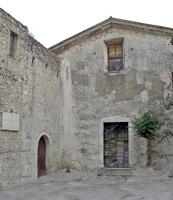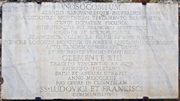


Bishop Benedetto authorised a community of male Franciscan tertiaries to build a church and hospice here in 1227. In 1392, the Franciscans ceded the complex to the nuns of Santa Maria della Stella.
The Blessed Christina Semenzi died here in 1458. She had visited Assisi in the previous year for the Festa del Perdono and there met Galizia, a lady from Spoleto who invited her to the city. She devoted her time there to serving the poor at San Matteo. She was buried under the Altare di San Michele in San Nicolò and a cult developed when miracles were reported at her tomb.
The Blessed Marina Petrucciani and a few other nuns moved here from the mother house in 1473, in order to form a reformed community. At this point, the activities of the hospice transferred to Santa Maria della Stella. (The Blessed Marina Petrucciani died here in 1501: her relics are now in San Ponziano). The nunnery was suppressed in 1798 and the complex was converted into a military hospital.
The military hospital absorbed the hospital of San Carlo Borromeo in 1801 to form the Ospedale di SS Carlo e Matteo, and the combined activities were concentrated on this site.

The Ospedale di SS Carlo e Matteo remained in operation here until 1939, when the new hospital opened in the ex-Collegio della Madonna di Loreto.
Art from San Matteo
St Helena (16th century)
This altarpiece, which is attributed to Livio Agresti, was recorded in the Ospedale di San Matteo in 1873. [Where is it now ??]

